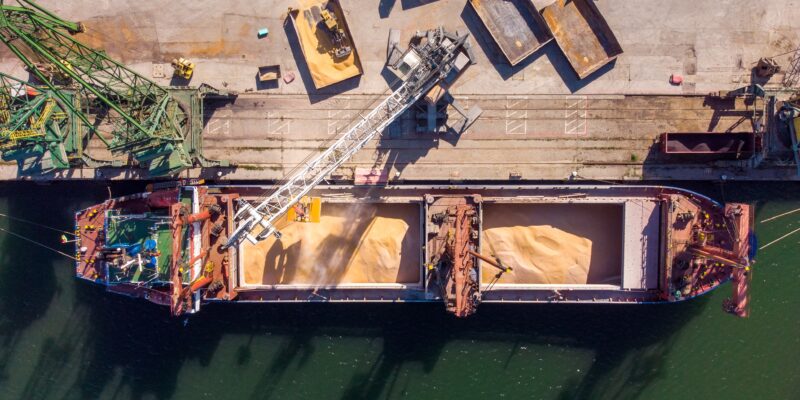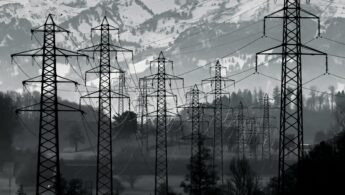Zero-carbon electricity: powering grids with wind and solar
Electricity grids are the backbone of global energy systems and are becoming increasingly important in the effort to limit global…

Deep sea mining refers to a process of collecting minerals from a depth of over 200 metres underwater. Three types of deep sea mining are currently being tested:
Mining companies consider the third option to be the most technologically feasible and financially promising. It involves collecting the nodules from the sea floor with a type of underwater bulldozer, and ploughing the top layers of sediment, with less invasive options still in development. The nodules are pumped up to a vessel at the surface and attached sediments and organic materials are then removed and pumped back into the water.
The Clarion-Clipperton Zone, in the middle of the Pacific Ocean, is of most interest to mining companies. The zone is divided into 16 exploration areas that are controlled by different countries. An ecologist at the Scripps Institution of Oceanography said that “the largest coal mine in Germany is less than half the size of the area that would be mined for polymetallic nodules in the Clarion-Clipperton Zone in one year by one contractor”.
As of yet, no official commercial mining operations have taken place in international waters. The International Seabed Authority (ISA), a United Nations-appointed body, is responsible for the regulation of international waters. This year, ISA failed to adopt a mining code that would regulate deep sea mining, and has set an indicative 2025 timeline to decide if and how countries may mine in international waters. Due to a two-year legal loophole, ISA may consider and provisionally approve a mineral exploitation contract submitted by a mining company, irrespective of whether rules are adopted and implemented.
So far, ISA has issued 31 exploration permits, which do not allow companies to undertake for-profit activities, in the past 20 years to national agencies and private companies for about one million square kilometres of exploration areas – equivalent to the size of Egypt. An international law expert said that even if the rules are finalised, ISA “does not have submersibles or ocean-going vessels at its disposal” to properly regulate activities and would need more financial resources to enforce rules. Brazil, Canada, Costa Rica, Chile, Finland, Germany, Portugal, Switzerland, Vanuatu and recently the UK are among the 23 countries opposed to fast-tracking deep sea mining licences, whereas China, Norway, Nauru and Mexico are in favour of it.
Individual countries are also allowed to mine the seabed in their own waters, called exclusive economic zones. Japan’s projects to mine domestic seabeds for rare earth have now moved to the development stage and are expected to begin in 2024. In 2019, a deep sea mining project failed in Papua New Guinea and left the country with PGK 375 million (USD 101 million) of debt.
Environmental organisations and scientists warn that the deep sea is largely unknown, and comprehensive studies are needed to understand what role deep sea ecosystems play in carbon sequestration, global temperature cycles, biodiversity and food provision for animals and humans. Little evidence is available on the damages that such mining operations would have through wastewater release or noise pollution, when compared to on-land mining. One study found that after 77 years, the seabed had not recovered from a shipwreck sliding over the sea floor.
It is also unclear who would be liable for those damages, and NGOs argue that due to the remoteness of the offshore mining areas, monitoring companies’ activities would be particularly challenging.
Technologies such as wind turbines, solar panels, batteries, EVs and electricity networks are key for a global transition to clean energy and a reduction of greenhouse gas emissions. Their production requires different types and quantities of critical minerals, such as cobalt, lithium and copper, which have been mined on land for decades.
While the proportion of total minerals mined that are used to produce clean energy technology is increasing, many minerals are used for a wide range of other purposes. Rare earth elements are used in the production of military equipment and weapons as well as robotics and air and space transport. Cobalt and nickel are integral for consumer electronics, and lithium is needed for lubricants, medication, ceramics and glass.
56% of lithium and 40% of cobalt are used for manufacturing clean energy technologies, but only 16% of mined nickel and 10% of neodymium, according to the International Energy Agency (IEA). Demand varies significantly depending on the mineral, and innovations such as cobalt-free batteries have reduced the need for some minerals. Table 1 shows the minerals used to manufacture different energy transition technologies.

There is no physical scarcity in the earth’s crust for most critical minerals, and reserves of minerals are often geographically widespread, as opposed to processing plants which are largely based in China. However, it is not clear if enough minerals are readily available to build the amount of solar PVs, wind turbines and batteries needed for a global transition to clean energy.
The IEA predicts an increased need for minerals in all its climate scenarios. However, demand is likely to peak in the coming decades – before 2045 in most scenarios. In the more ambitious Net Zero Scenario, mineral demand for clean energy technologies peaks on average in 2036. This is due to the fact that compared to fossil fuels, clean energy requires significantly less minerals. As explained in the World Energy Outlook, in a net zero world in 2050, every unit of energy would require two-thirds less materials, fossil fuels and minerals combined when compared to 2023.

Demand for minerals can be reduced through investments which accelerate innovation or high prices. The IEA had to reduce its projections for cobalt demand due to the development of lithium iron phosphate and high-nickel chemistries which do not require cobalt.
“A scenario which reflects current policy settings based on a sector-by-sector and country by country assessment of the specific policies that are in place, as well as those that have been announced by governments around the world.” STEPS does not include Nationally Determined Contributions (NDCs) – country action plans to cut emissions and adapt to climate impacts.
“A scenario which assumes that all climate commitments made by governments around the world, including NDCs and longer-term net zero targets, as well as targets for access to electricity and clean cooking, will be met in full and on time.”
“A scenario which sets out a pathway for the global energy sector to achieve net zero CO2 emissions by 2050. It doesn’t rely on emissions reductions from outside the energy sector to achieve its goals. Universal access to electricity and clean cooking are achieved by 2030.”
Short to medium-term supply shortages of minerals can occur due to geopolitical risks, such as:
Undersupply can also be caused by a lack of investment in upstream activities. “This can be driven by long lead times in opening new mines and processing of manufacturing plants, uncertainty regarding future demand, price volatility, a lack of downstream transparency, and local opposition”, according to the think tank IRENA. Another key issue is a lack of reliable statements from policymakers on national energy transitions. “If companies do not have confidence in countries’ energy and climate policies, they are likely to make investment decisions based on much more conservative expectations,” according to the IEA.
Mineral supply crunches are expected to have less devastating consequences than shortages of fossil fuels, and events similar to the 1970s oil crisis are improbable in a net-zero world. While a lack of fossil fuels in a fossil fuel economy affects all consumers using fuels such as gas, gasoline and fossil-powered electricity. A shortage of minerals in a net zero scenario only affects the production of technology such as solar panels, batteries and wind turbines or the construction of new energy assets.
Many minerals are currently extracted and processed in China. The country processes more than 50% of the world’s processed graphite, dysprosium, cobalt, lithium and manganese. Outside of China, economic players have “prioritised short-term profits over the importance of diversified supply chains”, according to the IEA. Developing clean energy technologies is therefore dependent on trade relationships with China, which is considered risky by many countries. To change that, the US currently offers production tax credits in the Inflation Reduction Act and the EU recently set domestic targets for extraction (10%), processing (40%) and recycling (15%).
Organisations and countries have different assessments of the potential criticality of minerals. Those differences are due to trade relationships, clean energy needs and targets, and domestic supply. Most countries and regions name cobalt, lithium, neodymium, nickel and indium as the most important critical minerals needed for clean energy technology.
The minerals with the greatest gap between current production and output needed to meet demand in 2030 are cobalt, copper, graphite, nickel and lithium. Similar conclusions on graphite and lithium are reached by the World Bank, which doesn’t account for battery technology improvements or similar innovations. Strong demand can also drive production. Lithium production increased by 21% globally in 2022 compared to 2021 amid strong demand for lithium-ion batteries and increased prices of lithium.[2]Excludes US production.
Copper, nickel and lithium are unlikely to suffer from supply chain crunches in the short term, and synthetic graphite could become a substitute for conventional graphite, according to a study commissioned by the European Commission. Rare earth elements, particularly dysprosium, are at “higher supply risk due to the higher rate of demand growth and lower proportion in rare earth ores.” Dysprosium is estimated to be available in the manganese crust in the deep sea, but not in polymetallic nodules. Graphite and lithium are also not available in polymetallic nodules.
The European Academies’ Science Advisory Council, an association of science academies, highlights that “three of the main metals targeted in deep-sea mining (manganese, copper, and nickel) are considered to be of low supply risk, while cobalt is moderate.” The IEA estimates that if all planned on-land critical minerals projects are carried out, “supply could be sufficient to support the Announced Pledges Scenario”.
The steepest growth in demand for minerals will take place in the present decade, according to the IEA’s predictions. After 2030, growth in demand for key minerals will continue at a lower rate in both ambitious and less ambitious scenarios (see Figures 1 and 2). If bottlenecks arise, they will more likely occur during this decade due to the steep growth in demand.
Since private or public companies have not yet extracted minerals from the deep sea on a large scale, and the technology to do so is not readily available on a large-scale, it seems unlikely that this solution will ease potential bottlenecks during the next seven years. Most deep-sea mining companies, apart from Canada-based The Metals Company, say they won’t be able to start commercial operations until towards the end of the decade, provided they receive clear regulatory signals. This is unlikely to happen until at least 2025, when the ISA is supposed to set rules on mining in international waters. Companies will likely only be ready to mine after demand for critical minerals has peaked and is declining.
It is also unclear if deep sea mining is cost-competitive compared to on-land mining. A report by think tank Planet Tracker shows that seafloor restoration would cost USD 5.3 million-5.7 million per square kilometre – more than the profit made from deep sea mining.


More sustainable land mining practices, battery recycling, substitution and demand reduction measures could reduce the likelihood of mineral supply crunches. This is especially important since minerals are used for a wide range of purposes outside of producing net zero technology. One study finds that “without sufficient and adequate resource saving measures it will be difficult or impossible for a substantial part of the future world population to attain the service level of mineral resources prevailing in developed countries at this moment.”
Declining ore grades, long permit times and waste characterise the mining sector on land. A just transition needs more investment in research and development and commitments to sustainable mining practices.[3]Initiatives include Towards Sustainable Mining (TSM) and the Initiative for Responsible Mining Assurance (IRMA). Mining in line with a just transition is also highly dependent on meaningful stakeholder dialogue, increased local ownership and sanctioning reporting gaps by mining companies.
There is an urgent need to diversify the supply of minerals. Despite Western countries highlighting the threats of putting all their eggs in one basket, the concentration of processing plants has increased in the last years for nickel and cobalt. Currently, around 70% of critical mineral reserves are located in Africa, where they are extracted and shipped in their crude form to China, where the refining, processing and manufacturing take place. From there, they are shipped to the US and EU.
Many Global South countries could be vital in reshaping the mining and processing landscape. Indonesia is a good example of how an export ban on raw materials has successfully pushed for investments in the local manufacturing sector. Hopes are high for India, too, which has announced plans to auction around 20 blocks of critical minerals.
Minerals and metals can be reused and recycled continuously if the right infrastructure and technologies are available – a significant advantage compared to fossil fuel infrastructure. The US has allocated a budget of about USD 6.33 billion for battery development, including recycling. The EU has set domestic targets for battery recycling in the EU Raw Materials Act of 15%. Similar and more ambitious measures such as extended producer responsibility, are necessary to ease medium to long-term bottlenecks.[4]Extended Producer Responsibility is a concept by which the producer has to take care of the product even after it isn’t used anymore. For instance, car producers would have to take back and recycle … Continue reading
Other factors unrelated to mineral sourcing, such as a lack of skilled employees, can play a role in bottlenecks. With mining operations being modernised, the sector increasingly needs a skilled workforce, such as engineers able to cope with new technology, automation and AI, and is struggling to attract young workers. Many workers currently in the mining sector are not fit for those challenges. A just transition requires upskilling and compensation mechanisms, particularly for local communities.
Sustained high prices for a material, pressures to reduce costs, geopolitical issues or environmental and social concerns can accelerate the search for alternative materials. “Perceptions that many metals are critical and scarce for renewable energy transitions appear exaggerated if a dynamic view on technological development is adopted,” one study found. Current lithium-ion batteries require cobalt or nickel, but new alternatives such as Svolt’s cobalt-free lithium-ion car battery or Tesla’s lithium-ion phosphate batteries reduce demand for those minerals. An IEA report showed that between 2005 and 2018, patenting for batteries and similar storage technologies grew at an average rate of 14% worldwide every year, four times faster than the average for all technology.
In a world of scarcity and environmental fragility, reducing demand is necessary and increasingly plays a role in projections. Restricted lithium availability raises questions about the sustainable use of battery electric vehicles. Globally, 40% of battery electric vehicles are SUVs, and only roughly 20% are small-sized cars. In the US, SUVs account for 60%, and less than 10% are small cars. Similarly, 37% of households in the US possess two vehicles. These trends push up the size of the battery, the requirement of minerals and the prices, excluding many households from participating in sustainable practices. Nevertheless, if all announced manufacturing plans for EV batteries are implemented globally, there would be enough capacity to fulfil expected demand requirements in 2030 in the IEA’s NZE Scenario for EVs.
Poorly developed electricity networks are a significant bottleneck in the energy transition. An IEA report highlights that companies and governments fail to connect renewables to the grid due to the lack of developed electricity networks. Renewable energy projects worth 3000 GW are queuing to get connected to the grids, which “is five times the amount of solar PV and wind capacity that was added worldwide last year.” Currently, getting grid permits takes five to seven years in the UK, five years in Italy and three years in Spain and France. Rapid grid connection becomes more urgent than manufacturing new solar PVs and wind turbines if emissions are to be reduced today.
References
| ↑1 | Assumptions underpinning scenarios are often based on current conditions and then extrapolated to future demand. |
|---|---|
| ↑2 | Excludes US production. |
| ↑3 | Initiatives include Towards Sustainable Mining (TSM) and the Initiative for Responsible Mining Assurance (IRMA). |
| ↑4 | Extended Producer Responsibility is a concept by which the producer has to take care of the product even after it isn’t used anymore. For instance, car producers would have to take back and recycle batteries of cars after their end of life. |

Electricity grids are the backbone of global energy systems and are becoming increasingly important in the effort to limit global…

Greenwashing can take various forms, such as false advertising or misleading labelling. This guide shows how to spot greenwashing in…